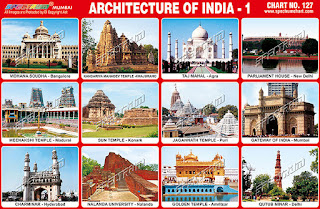 |
| Architecture of India Chart |
Spectrum Chart - 127 : Architecture of India 1
- Vidhan Soudha (Bengaluru) - Vidhana Soudha located in Bengaluru, is the seat of the state legislature of Karnataka. It is an imposing building, constructed in a style sometimes described as Mysore Neo-Dravidian. It's construction was completed in 1956.
- Kandariya Mahadev Temple (Khajuraho) - Kandariya Mahadeva Temple is the largest and most ornate Hindu temple in the medieval temple group found at Khajuraho. The temple is dedicated to Lord Shiva, in the form of a linga. It was made in 1030 by King Vidhyadhara of Chandela dynasty.
- Taj Mahal (Agra) - Taj Mahal is known as a symbol of love. Taj Mahal is an ivory-white marble mausoleum on the south bank of the Yamuna river in the Indian city of Agra. It was built by the Mughal Emperor Shah Jahan in the memory of his wife Mumtaz Mahal. Construction of Taj Mahal took 22 years & was completed in 1653.
- Parliament House (New Delhi) - Sansad Bhawan (Parliament Building) is the house of the Parliament of India, located in New Delhi. Construction of parliament house began in 1921. The opening ceremony of the Parliament House was performed on 18 January 1927 by Lord Irwin, the then Viceroy of India.
- Meenakshi Temple (Madurai) - Meenakshi Temple is a historic Hindu temple located on the southern bank of the Vaigai River in the temple city of Madurai. It is dedicated to Parvati, known as Meenakshi. The temple was originally built in 6th century BC. The temple was rebuilt by Viswanatha Nayak (1559–1600), the first Nayak king of Madurai, after it was destructed by a muslim invader Malik Kafur in 14th century.
- Sun Temple (Konark) - It is believed that the Sun Temple in Konark was built by king Narasimhadeva I of Eastern Ganga Dynasty around 1250 CE. A major part of the structure is now in ruins. The temple is a UNESCO World Heritage Site.
- Jagannath Temple (Puri) - Jagannath Temple of Puri is a famous, sacred Hindu temple dedicated to Jagannath and located on the eastern coast of India, at Puri in the state of Odisha. The temple was built in the 12th century atop its ruins by the progenitor of the Eastern Ganga dynasty, King Anantavarman Chodaganga Deva.
- Gateway Of India (Mumbai) - The Gateway of India was built to commemorate the visit of King George V and Queen Mary to Mumbai in December 1911. The construction of the monument was completed in 1924. The last British troops to leave India following the country's independence, the First Battalion of the Somerset Light Infantry, passed through the gateway on their way out in a ceremony on 28 February 1948, signalling the end of British rule.
- Charminar (Hyderabad) - Charminar is a monument and mosque located in Hyderabad. Sultan Muhammad Quli Qutb Shah built the Charminar in 1591. After shifting his capital from Golkonda to Hyderabad. The landmark has become a global icon of Hyderabad.
- Nalanda University (Nalanda) - Founded in the 5th Century A.D. Nalanda is known as the ancient seat of learning. 2,000 Teachers and 10,000 Students from all over the Buddhist world lived and studied at Nalanda, the first Residential International University of the World. The University flourished during the 5th and 12th century.
- Golden Temple (Amritsar) - Golden Temple (also known as Sri Harmandir Sahib) is the holiest Gurdwara of Sikhism, located in the city of Amritsar, Punjab. The fifth Sikh Guru, Guru Arjan, designed the Harmandir Sahib to be built in the center of this holy tank and upon its construction, installed theAdi Granth, the holy scripture of Sikhism, inside the Harmandir Sahib.
- Qutub Minar (Delhi) - Qutub Minar at 120 meters, is the tallest brick minaret in the world. Qutub Minar, along with the ancient and medieval monuments surrounding it, form the Qutub Complex, which is a UNESCO World Heritage Site. The construction of Qutub Minar was commissioned by Qutub-ud-Din Aibak, the founder of the Delhi Sultanate in 1199 AD.

No comments:
Post a Comment